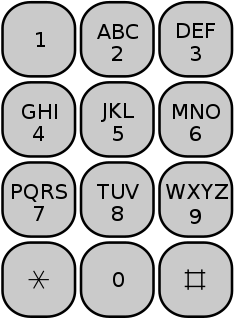
SMS is a text messaging service component of most telephone, Internet, and mobile device systems. It uses standardized communication protocols to enable mobile devices to exchange short text messages. An intermediary service can facilitate a text-to-voice conversion to be sent to landlines. SMS was the most widely used data application at the end of 2010, with an estimated 3.5 billion active users, or about 80% of all mobile subscribers.
Signaling System No. 7 (SS7) is a set of telephony signaling protocols developed in 1975, which is used to set up and tear down telephone calls in most parts of the world-wide public switched telephone network (PSTN). The protocol also performs number translation, local number portability, prepaid billing, Short Message Service (SMS), and other services.
An intrusion detection system (IDS) is a device or software application that monitors a network or systems for malicious activity or policy violations. Any malicious activity or violation is typically reported either to an administrator or collected centrally using a security information and event management (SIEM) system. A SIEM system combines outputs from multiple sources, and uses alarm filtering techniques to distinguish malicious activity from false alarms.

A telephone call is a connection over a telephone network between the called party and the calling party.
The ISDN User Part or ISUP is part of Signaling System No. 7 (SS7), which is used to set up telephone calls in the public switched telephone network (PSTN). It is specified by the ITU-T as part of the Q.76x series.
VoIP spam or SPIT is unsolicited, automatically dialed telephone calls, typically using voice over Internet Protocol (VoIP) technology.
Customized Applications for Mobile networks Enhanced Logic (CAMEL) is a set of standards designed to work on either a GSM core network or the Universal Mobile Telecommunications System (UMTS) network. The framework provides tools for operators to define additional features for standard GSM services/UMTS services. The CAMEL architecture is based on the Intelligent Network (IN) standards, and uses the CAP protocol. The protocols are codified in a series of ETSI Technical Specifications.
A host-based intrusion detection system (HIDS) is an intrusion detection system that is capable of monitoring and analyzing the internals of a computing system as well as the network packets on its network interfaces, similar to the way a network-based intrusion detection system (NIDS) operates. This was the first type of intrusion detection software to have been designed, with the original target system being the mainframe computer where outside interaction was infrequent.
In voice telecommunications, least-cost routing (LCR) is the process of selecting the path of outbound communications traffic based on cost. Within a telecoms carrier, an LCR team might periodically choose between routes from several or even hundreds of carriers for destinations across the world. This function might also be automated by a device or software program known as a "Least Cost Router."

Numbers on the Irish Telephone Numbering Plan are regulated and assigned to operators by ComReg.
Termination rates are the charges which one telecommunications operator charges to another for terminating calls on its network. Traditionally three models of charging these fees are known: calling party pays (CPP), bill and keep, receiving party pays (RPP).
In telecommunication, supervision is the monitoring of a telecommunication circuit for telephony to convey to an operator, user, or a switching system, information about the operational state of the circuit. The typical operational states of trunks and lines are the idle and busy states, seizure, and disconnect. The states are indicated by various electrical signals and electrical conditions depending of the type of circuit, the type of terminating equipment, and the type of intended service.
1-5-7-1 is the name of a family of calling features in the United Kingdom, for residential and business telephone lines and for mobile telephones, that are provided by BT Group and several other telephone service providers. The family is named after the telephone number 1571, the special service number that is used to access it. Call Minder is the name of BT's highest level of 1571 service.
Trainline, formerly branded Thetrainline.com, is an independent digital rail and coach platform. It sells tickets through its website, by telephone, and through its mobile app which is available on iOS, Windows Phone and Android platforms.
Data loss prevention software detects potential data breaches/data ex-filtration transmissions and prevents them by monitoring, detecting and blocking sensitive data while in use, in motion, and at rest.
Trusteer is a portfolio of digital identity trust software products belonging to IBM Security. Founded by Mickey Boodaei and Rakesh K. Loonkar, in Israel in 2006, Trusteer was acquired in September 2013 by IBM for $1 billion, which was the highest valuation multiple that IBM has ever paid for a business.
"Calling party pays" or CPP is a payment model in telephony, especially in cellular markets, that states that the total cost of a call is borne by the caller and not the receiver. It is also known as "Calling party network pays" or CPNP.

Telefonica O2 UK Ltd v British Telecommunications plc [2014] UKSC 42 is a UK enterprise law, concerning telecommunications.




